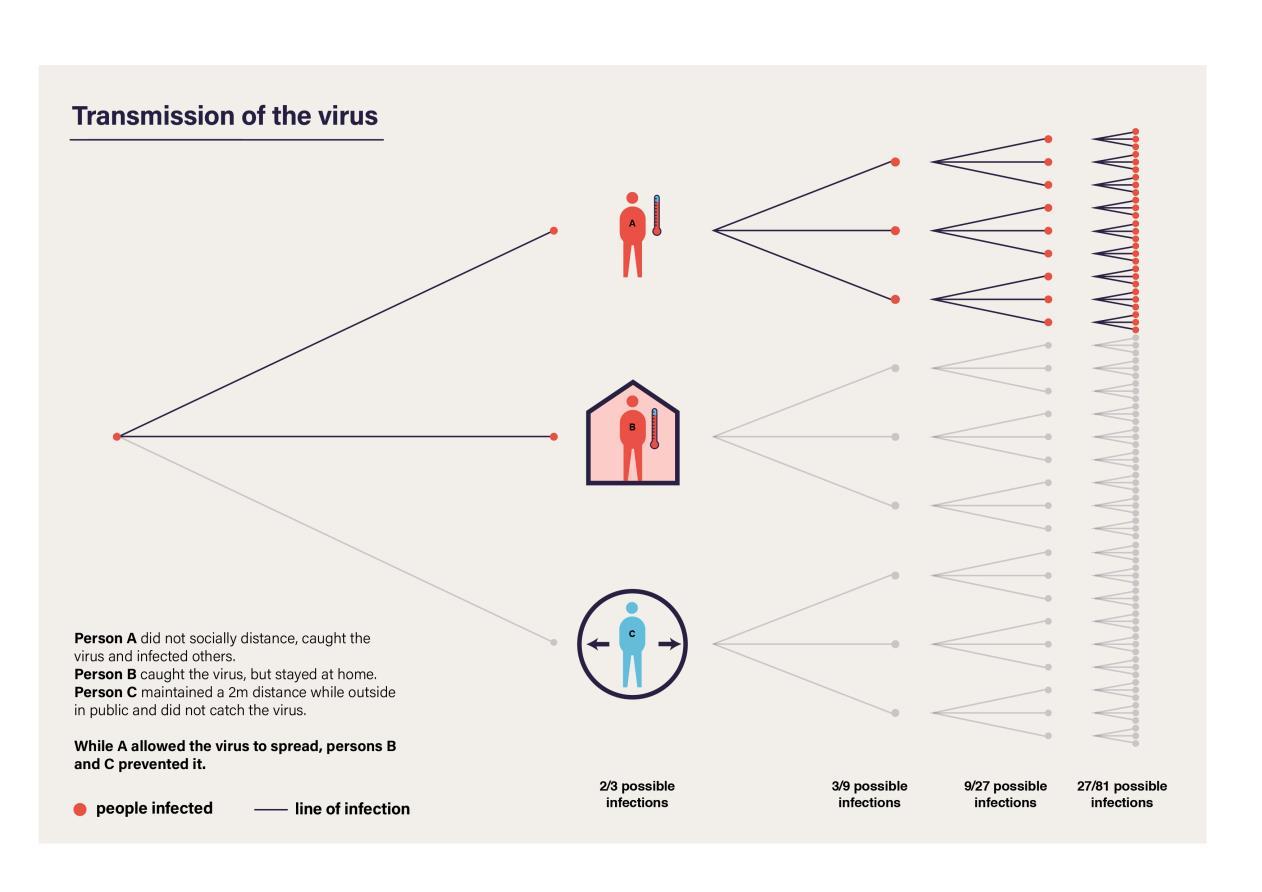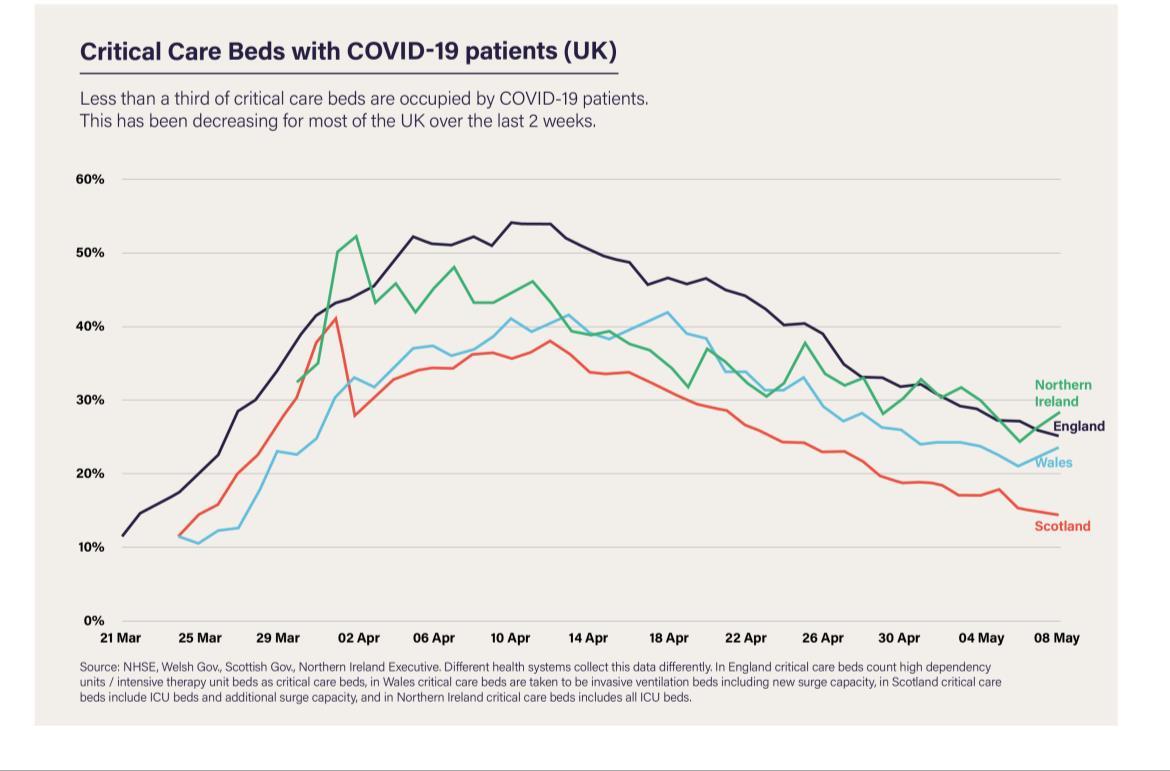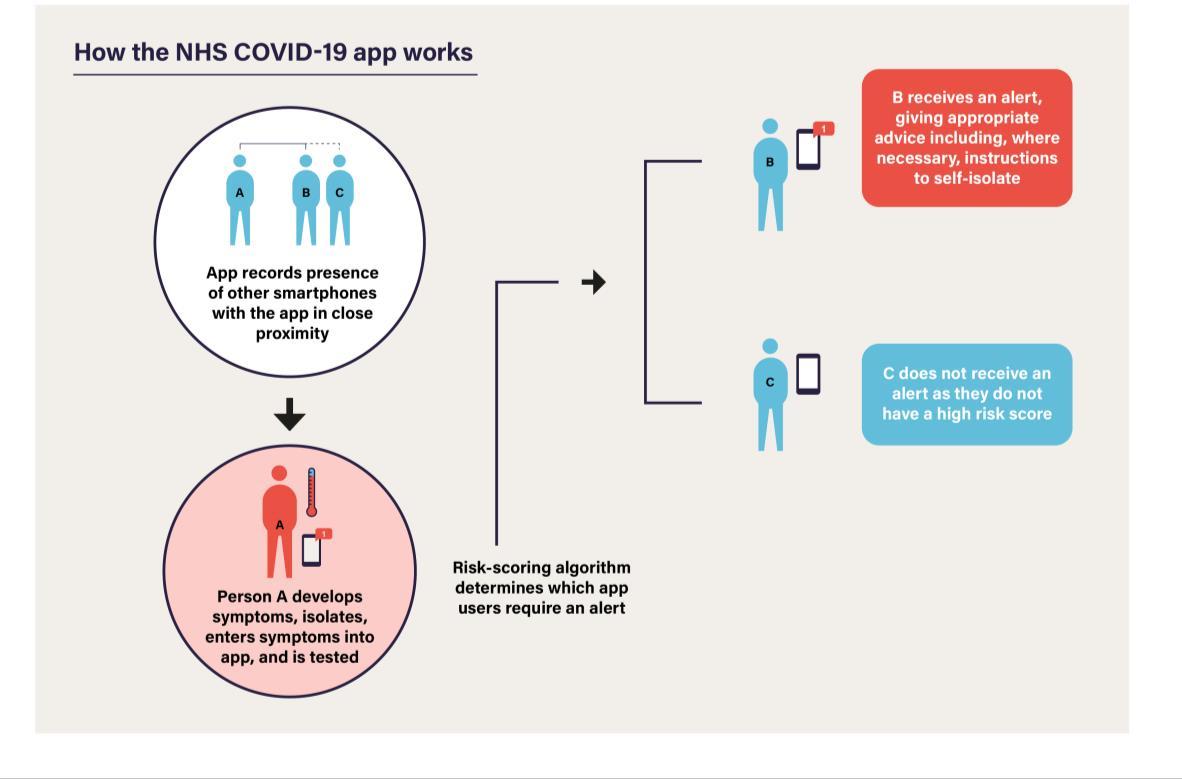
11 minute read
1. The current situation
Phase one
COVID-19 is a new and invisible threat. It has spread to almost every country in the world.
Advertisement
The spread of the virus has been rapid. In the UK at its maximum, the number of patients in intensive care was estimated to be doubling every 3-4 days.
This type of exponential growth would have overwhelmed the NHS were it not contained (as shown in Figure 1).
Figure 1: Illustrative profile of the epidemic under different approaches Illustrative impact of social and behavioural interventions lasting several months on a Reasonable Worst Case epidemic.
From the start, the Government was guided by science, publishing on 3 March its plan 2 to contain, delay, and mitigate any outbreak, and use research to inform policy development.
Responding to the advice of Government scientists, on 7 March those with symptoms were asked to self-isolate for 7 days. On 16 March, the Government introduced shielding for the most vulnerable and called on the British public to cease non-essential contact and travel. On 18 March, the Government announced the closure of schools. On 20 March entertainment, hospitality and indoor leisure venues were closed. And on 23 March the Government took decisive steps to introduce the Stay at Home guidance. Working with the devolved administrations, the Government had to take drastic action to protect the NHS and save lives. Delivering this plan was the first phase of the Government’s response, and due to the extraordinary sacrifice of the British people and the efforts of the NHS, this first phase has suppressed the spread of the virus.
In an epidemic, one of the most important numbers is R - the reproduction number. If this is below one, then on average each infected person will infect fewer than one other person; the number of new infections will fall over time. The lower the number, the faster the number of new infections will fall. When R is above one, the number of new infections is accelerating; the higher the number the faster the virus spreads through the population.
Figure 2: Transmission of the virus Schematic diagram of the transmission of the virus with an R value of 3, and the impact ofsocial distancing.

In the UK, the Scientific Advisory Group for Emergencies (SAGE) assessed that R at the beginning of the epidemic was between 2.7 and 3.0; each person with the disease gave it to nearly three other people, on average. But the Government and devolved administration response means SAGE’s latest assessment is that, across the UK, R has reduced to between 0.5 and 0.9, meaning that the number of infected people is falling. The impact of social distancing measures on R is demonstrated in Figure 2.
The Government now sees that:
There are no regions of the country where the epidemic appears to be increasing.
As of 9 May, it is estimated that 136,000 people in England are currently infected with COVID-19. 3
The number of patients in hospital in the UK with COVID-19 is under 13,500 as of 4 May; 35% below the peak on 12 April. 4
27% of NHS critical care beds in the UK were occupied by a COVID-19 patient on 4 May - compared to 51% on 10 April. 5
At the same time, the Government has invested heavily in its ability to tackle the disease. NHS capacity has increased significantly, with 3,000 new critical care beds across the UK since January 6 , and daily tests have increased by over 1,000% during April - from 11,041 on 31 March to 122,347 on 30 April. 7
3 https://www.ons.gov.uk/peoplepopulationandcommunity/healthandsocialcare/conditionsanddiseases/ bulletins/coronaviruscovid19infectionsurvey/england10may2020 4 Source: NHSE (COVID daily sitrep), Scottish Gov, Welsh Gov, NI. Note: For NHS acute trusts with Type 1 A&E only 5 Source: NHSE (COVID daily sitrep, A&E daily sitrep), Welsh Gov, Scottish Gov, NI Gov. Different health systems collect this data differently; in Wales critical care beds are taken to be invasive ventilation including surge capacity and both confirmed and suspected COVID-19 cases, in Scotland critical care beds include ICU beds and additional surge capacity. In Northern Ireland, critical care beds includes all adult ICU beds (this is a change to previous reporting). Note: For NHS acute trusts with Type 1 A&E only. 6 NHSE (COVID daily sitrep), Scottish Gov, Welsh Gov, NI. Note: For NHS acute trusts with Type 1 A&E only 7 https://www.gov.uk/guidance/coronavirus-covid-19-information-for-the-public. This data includes tests under Pillars 1 and 2 for March. Our cumulative total of 1,023,824 tests by 30 April compares with 2.5m tests in Germany, 724,000 in France and 640,000 in South Korea (PHE collation of data from national published sources)
Figure 3: Daily tests (UK) The number of tests carried out in the UK as of 9am on 9 May

Tragically, however, the number of deaths so far this year is 37,151 higher than the average for 2015 to 2019. 8 The Government is particularly troubled by the impact of COVID-19 in care homes, where the number of COVID-19 deaths registered as taking place up to 24 April is 6,934, 9 and by the higher proportion of those who have died of COVID-19 who have been from minority ethnic backgrounds. It is critical that the Government understands why this is occurring. It is why on 4 May Public Health England launched a review into the factors affecting health outcomes from COVID-19, to include ethnicity, gender and obesity. This will be published by the end of May. 10
Alongside the social distancing measures the Government has announced in this first phase, it has also taken unprecedented action to support people and businesses through this crisis and minimise deep and long-lasting impacts on the economy. 800,000 employers had applied to the Coronavirus Job Retention Scheme to help pay the wages of 6.3m jobs, as of midnight on 3 May. 11
The Office for Budget Responsibility (OBR) and the Bank of England have both been clear that if the Government had not taken the actions they had, the situation would be much worse. But despite this, the impact on people’s jobs and livelihoods has been severe: economic activity has been brought to a stop across large swathes of the UK economy. The Government is supporting millions of families and businesses, but cannot protect every job and every business.
8 https://www.ons.gov.uk/peoplepopulationandcommunity/birthsdeathsandmarriages/deaths/ datasets/weeklyprovisionalfiguresondeathsregisteredinenglandandwales; https://www.nrscotland.gov.uk/covid19stats; https://www.nisra.gov.uk/publications/weekly-deaths 9 https://www.ons.gov.uk/peoplepopulationandcommunity/birthsdeathsandmarriages/deaths/ datasets/weeklyprovisionalfiguresondeathsregisteredinenglandandwale 10 https://www.gov.uk/government/news/review-into-factors-impacting-health-outcomes-from-covid-19 11 HMRC, https://twitter.com/HMRCgovuk/status/1257324798847451136/photo/1
Unemployment is rising from a 40-year low at the start of the year; around 1.8 million households made claims for Universal Credit between 16 March and 28 April. 12 The OBR has published a ‘reference’ scenario which suggests that, if the current measures stay in place until June and are then eased over the next three months, unemployment would rise by more than 2 million in the second quarter of 2020. 13 The OBR’s scenario suggests that GDP could fall by 35% in the second quarter of this year –and the annual contraction could be the largest in over 300 years. 14
Workers in those sectors most affected, including hospitality and retail, are more likely to be low paid, younger and female. Younger households are also likely to be disproportionately hit in the longer term, as evidence suggests that, following recessions, lost future earnings potential is greater for young people. 15
The longer the virus affects the economy, the greater the risks of long-term scarring and permanently lower economic activity, with business failures, persistently higher unemployment and lower earnings. This would damage the sustainability of the public finances and the ability to fund public services including the NHS. It would also likely lead to worse long-run physical and mental health outcomes, with a significant increase in the prevalence of chronic illness.
12 DWP, https://www.gov.uk/government/publications/universal-credit-declarations-claims-and-advancesmanagement-information 13 OBR, https://obr.uk/docs/dlm_uploads/Coronavirus_reference_scenario_commentary.pdf 14 OBR, https://obr.uk/docs/dlm_uploads/Coronavirus_reference_scenario_commentary.pdf 15 IFS, https://www.ifs.org.uk/publications/14791
Moving to the next phase
On 16 April the Government presented five tests for easing measures 16 . These are:

The Government’s priority is to protect the public and save lives; it will ensure any adjustments made are compatible with these five tests. As set out above, the R is now below 1 –between 0.5 and 0.9 –but potentially only just below 1 . The Government has made good progress in satisfying some of these conditions. The ventilated bed capacity of the NHS has increased while the demand placed on it by COVID-19 patients has now reduced (as shown in Figure 4). Deaths in the community are falling. However, real challenges remain on the operational support required for managing the virus. The Government cannot yet be confident that major adjustments now will not risk a second peak of infections that might overwhelm the NHS. Therefore, the Government is only in a position to lift cautiously elements of the existing measures.
Figure 4: Critical care beds with COVID-19 patients (UK) The percentage of critical care beds with COVID-19 patients up to 8 May.

Different parts of the UK have different R figures. The devolved administrations are making their own assessments about the lifting of measures in Scotland, Wales and Northern Ireland. All governments continue to work together to ensure a coordinated approach across the United Kingdom.
The challenges ahead
As the Government moves into the next phase of its response to the virus, it is important to be clear about the challenges that the UK, in common with other countries around the world, is now facing.
1. This is not a short-term crisis. It is likely that COVID-19 will circulate in the human population long-term, possibly causing periodic epidemics. In the near future, large epidemic waves cannot be excluded without continuing some measures.
2. In the near term, we cannot afford to make drastic changes. To successfully keep R below 1, we have little room for manoeuvre. SAGE modelling suggests that either fully opening schools or relaxing all social distancing measures now, will lead to a resurgence of the virus and a second wave that could be larger than the first. In a population where most people are lacking immunity, the epidemic would double in size every few days if no control measures were in place.
3. There is no easy or quick solution. Only the development of a vaccine or effective drugs can reliably control this epidemic and reduce mortality without some form of social distancing or contact tracing in place. In the medium-term, allowing the virus to spread in an uncontrolled manner until natural population-level immunity is achieved would put the NHS
under enormous pressure. At no point has this been part of the Government's strategy. If vaccines can be developed they have the potential to stop the disease spreading; treatments would be less likely to stop the spread but could make the virus less dangerous.
4. The country must get the number of new cases down. Holding R below 1 will reduce the number of new cases down to a level that allows for the effective tracing of new cases; this in turn, will enable the total number of daily transmissions to be held at a low level.
5. The world’s scientific understanding of the virus is still developing rapidly. We are still learning about who is at greatest personal risk and how the virus is spread. It is not possible to know with precision the relative efficacy of specific shielding and suppression measures; nor how many people in the population are or have been infected asymptomatically.
6. The virus’ spread is difficult to detect. Some people carry the disease asymptomatically, which may mean that they can spread the virus without knowing that they are infectious. Those who do develop symptoms often do not show signs of being infected for around five days; a significant proportion of infections take place in this time, particularly in the two days before symptoms start. Even those who are not at risk of significant harm themselves may pose a real risk of inadvertently infecting others. This is why a significant part of the next phase of the Government’s response will be to improve its monitoring of and response to new infections.
7. The Government must prepare for the challenges that the winter flu season will bring. This will have wide-ranging effects, from impeding any efforts to trace the virus (because so many people without COVID-19 are likely to have symptoms that resemble COVID-19), to increasing the demand for hospital beds.
8. The plan depends on continued widespread compliance. So far people have adhered to the measures well, as depicted in Figure 5 below. However, to avoid R tipping above 1 and the epidemic increasing in an uncontrolled manner, very high continued levels of compliance are essential. The risk is an unbalanced one; if the UK tips back into an exponential increase in the spread of the infection, it could quickly get out of control.
Figure 5: Mobility trends data for the UKbased on a seven-day rolling average up to 7 May

Reflecting these challenges, the rest of this document sets out a cautious roadmap to ease existing measures in a safe and measured way, subject to successfully controlling the virus and being able to monitor and react to its spread. The roadmap will be kept constantly under review as the epidemic, and the world's understanding of it, develops.






